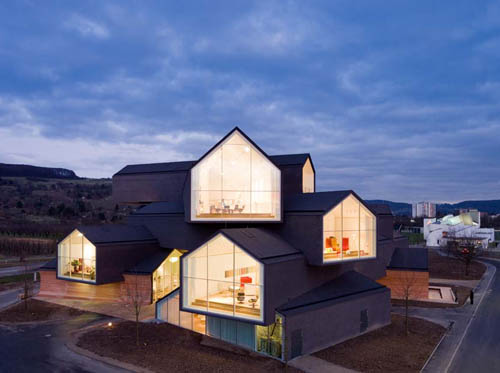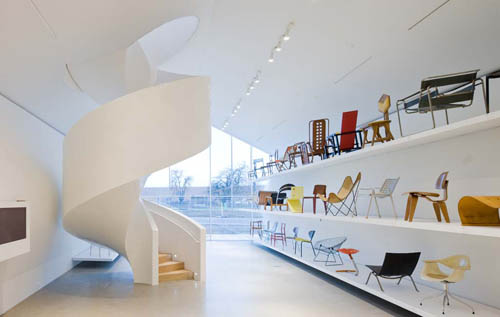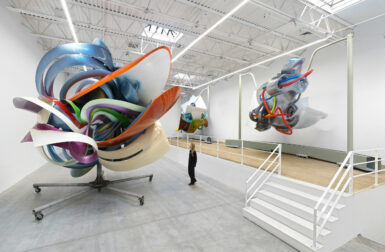
This could be one of my most favorite buildings of 2010.
The newest addition to the Vitra Campus in Weil am Rhein, Germany is VitraHaus. Vitra’s Home Collection was in need of its own dedicated space on the Vitra Campus, so Vitra commissioned Basel-based architects Herzog & de Meuron in 2006 to design a suitable home. Thus, VitraHaus came to be — completed and open just this month.
Located on the northern side of the campus in front of the fenced perimeter of the production premises, the VitraHaus joins two other buildings in this area, the Vitra Design Museum by Frank Gehry (1989) and the Conference Pavilion by Tadao Ando (1993).
The exterior design follows the theme of the archetypal house and the theme of stacked volumes, apparent in the work of Herzog & de Meuron. It features five stories and its sole function is to present the contemporary Vitra Home Collection. Inside, the furnishings are arranged in a variety of settings for both living and working: classics by Charles & Ray Eames, George Nelson, Isamu Noguchi, Jean Prouvé and Verner Panton are combined with contemporary designs by Maarten Van Severen, Ronan & Erwan Bouroullec, Antonio Citterio, Hella Jongerius, Jasper Morrison and others. It’s a modernist’s dream home, full of inspiration and, for me, drooling. You can also order furnishings on-site.










More about the architecture:
Due to the proportions and dimensions of the interior spaces – the architects use the term ‘domestic scale’ – the showrooms are reminiscent of familiar residential settings. The individual ‘houses’, which have the general characteristics of a display space, are conceived as abstract elements. With just a few exceptions, only the gable ends are glazed, and the structural volumes seem to have been shaped with an extrusion press. Stacked into a total of five stories and breathtakingly cantilevered up to 49 feet in some places, the twelve houses, whose floor slabs intersect the underlying gables, create a three-dimensional assemblage – a pile of houses that, at first glance, has an almost chaotic appearance…
The charcoal color of the exterior stucco skin unifies the structure, ‘earths’ it and connects it to the surrounding landscape. Like a small, vertically layered city, the VitraHaus functions as an entryway to the Campus. A wooden plank floor defines an open central area, around which five buildings are grouped: a conference area, an exhibition space for the chair collection of the Vitra Design Museum and a conglomerate comprising the Vitra Design Museum Shop, the lobby with a reception area and cloakroom, and a café with an outdoor terrace for summer use. A lift takes visitors to the fourth storey, where the circular tour begins. Upon exiting the lift, the glazed northern end of the room offers a spectacular view of the Tüllinger Hill. The opposite end – where the glass front is recessed to create an exterior terrace – opens to a panorama of Basel with the industrial facilities of the pharmaceutical sector. As one discovers on the path through the VitraHaus, the directional orientation of the houses is hardly arbitrary, but is determined by the views of the surrounding landscape.
The complexity of the interior space arises not only from the angular intersection of the individual houses but also from the integration of a second geometrical concept. All of the staircases are integrated into expansive, winding organic volumes that figuratively eat their way through the various levels of the building like a worm, sometimes revealing fascinating visual relationships between the various houses, at other times blocking the view. The interior walls are finished in white in order to give priority to the furniture displays.
With maximum dimensions of 187 feet in length, 177 feet in width and 69.8 feet in height, the VitraHaus rises above the other buildings on the Vitra Campus. The deliberate intention was not to create a horizontal building, the common type for production facilities, but rather a vertically oriented structure with a small footprint, which grants an overview in multiple senses: an overview of the surrounding landscape and the factory premises, but also an overview of the Home Collection. Just as interior and exterior spaces interpenetrate, so do two types of forms: the orthogonal-polygonal, as perceived from the exterior, and the organic, which produces a series of spatial surprises in the interior – a ‘secret world’ (in the words of Herzog & de Meuron) with a suggestive, almost labyrinthine character. On their path through the five stories, visitors traverse the Vitra Home cosmos, ultimately returning to their starting point.
The VitraHaus is open Monday to Sunday from 10 am to 6 pm.
Images copyright Vitra and photography by Iwan Baan.






